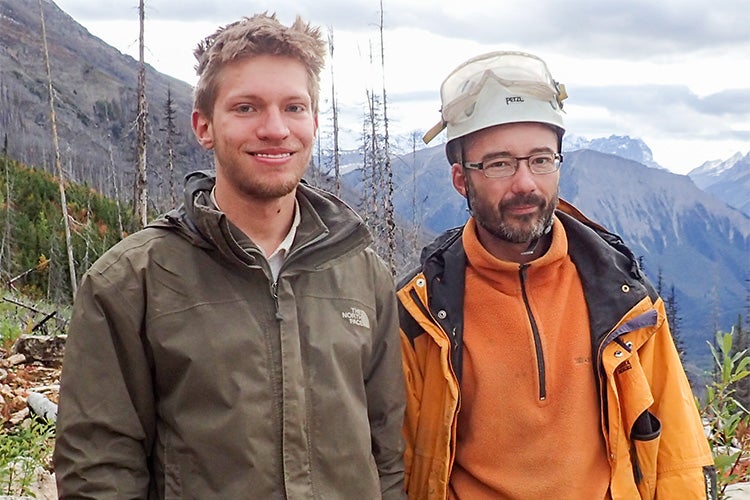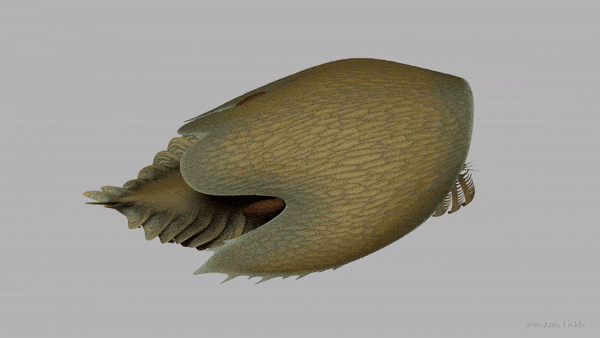Paleontologists at U of T and ROM discover fossils of new predatory species in Canadian Rockies

Published: August 1, 2019
Paleontologists at the University of Toronto and the Royal Ontario Museum have uncovered fossils of a large new predatory species in half-a-billion-year-old rocks from Kootenay National Park in the Canadian Rockies.
This new species has rake-like claws and a pineapple-slice-shaped mouth at the front of an enormous head, and it sheds light on the diversity of the earliest relatives of insects, crabs, spiders and their kin. The findings were announced a study published Wednesday in Proceedings of the Royal Society B.
Reaching up to a foot in length, the new species, named Cambroraster falcatus, comes from the famous 506-million-year-old Burgess Shale.
“Its size would have been even more impressive at the time it was alive, as most animals living during the Cambrian Period were smaller than your little finger,” said Joe Moysiuk, a PhD student in the department of ecology and evolutionary biology in the Faculty of Arts & Science and lead author of the study. He is based at the Royal Ontario Museum (ROM).
“Cambroraster was a distant cousin of the iconic Anomalocaris, the top predator living in the seas at that time, but it seems to have been feeding in a radically different way,” Moysiuk said.

PhD student Joe Moysiuk (left) and Associate Professor Jean-Bernard Caron working at the Burgess Shale in Kootenay National Park (photo courtesy of Joe Moysiuk)
The name Cambroraster refers to the remarkable claws of this animal, which bear a parallel series of outgrowths, looking like forward-directed rakes.
“We think Cambroraster may have used these claws to sift through sediment, trapping buried prey in the net-like array of hooked spines,” said Jean-Bernard Caron, an associate professor in the departments of Earth sciences and ecology and evolutionary biology. Caron is based at the ROM and is Moysiuk’s research supervisor.
With the space between the spines on the claws at typically less than a millimetre, this would have enabled Cambroraster to feed on very small organisms, although larger prey could also likely be captured, and ingested into the circular, tooth-lined mouth. This specialized mouth apparatus is the namesake of the extinct group Radiodonta, which includes both Cambroraster and Anomalocaris. Radiodonta is considered to be one of the earliest offshoots of the arthropod lineage, which today includes all animals with an exoskeleton, a segmented body and jointed limbs.
The second part of the species name – falcatus – was given in tribute to another of Cambroraster’s distinctive features: the large shield-like carapace covering its head, which is shaped like the Millennium Falcon spaceship from the Star Wars films.
“With its broad head carapace with deep notches accommodating the upward facing eyes, Cambroraster resembles modern living bottom-dwelling animals like horseshoe crabs. This represents a remarkable case of evolutionary convergence in these radiodonts,” Moysiuk said.

(Animation by Lars Fields/Royal Ontario Museum)
Such convergence is likely reflective of a similar environment and mode of life – like modern horseshoe crabs, Cambroraster may have used its carapace to plough through sediment as it fed.
Researchers were surprised by the large number of specimens recovered. “The sheer abundance of this animal is extraordinary,” said Caron, who is also the Richard M. Ivey Curator of Invertebrate Palaeontology at the ROM and leader of the field expeditions that unearthed the new fossils.
“Over the past few summers we found hundreds of specimens, sometimes with dozens of individuals covering single rock slabs.”
Based on more than 100 exceptionally well-preserved fossils now housed at the ROM, researchers were able to reconstruct Cambroraster in unprecedented detail, revealing characteristics that had not been seen before in related species.
“The radiodont fossil record is very sparse; typically, we only find scattered bits and pieces,” said Caron. “The large number of parts and unusually complete fossils preserved at the same place are a real coup, as they help us to better understand what these animals looked like and how they lived. We are really excited about this discovery.”
Fossils from the Cambrian Period, particularly from sites like the Burgess Shale, record a dramatic “explosion” of biodiversity at this time, culminating in the evolution of most of the major groups of animals that survive today. But, the story has far more intricacy than a straight line leading from simple ancestors to the vast diversity of modern species.
“Far from being primitive, radiodonts show us that at the very outset of complex ecosystems on Earth, early representatives of the arthropod lineage rapidly radiated to play a wide array of ecological roles,” said Moysiuk.

At left, the circular mouth apparatus of Cambroraster, showing rows of toothed plates. The right photo shows an isolated head carapace of Cambroraster, with deep notches that accommodated the eyes (photos courtesy of Jean-Bernard Caron)
The fossils were found at several sites in the Marble Canyon area in Kootenay National Park, B.C., which have been discovered by ROM-led field teams since 2012, with some of the key specimens unearthed just last summer. These sites are about 40 kilometres away from the original Burgess Shale fossil site in Yoho National Park that was first discovered in 1909. What is also exciting for researchers is the realization that there is a large new area in northern Kootenay National Park worth scientific exploration, holding the potential for the discovery of many more new species.
The Burgess Shale fossil sites are located within Yoho and Kootenay National Parks and are managed by Parks Canada.
The discovery and study of Cambroraster will be profiled in the upcoming episode of CBC’s The Nature of Things airing on Oct. 18, and on the free CBC Gem streaming service. These and other Burgess Shale specimens will be showcased in a new gallery at the ROM, the Willner Madge Gallery, Dawn of Life, expected to open in 2021. Starting this summer, select specimens of Cambroraster will be put on display in the New Research case within the current temporary Willner Madge Gallery, Dawn of Life preview exhibition.
Funding support for the research and fieldwork was provided by the Natural Sciences and Engineering Research Council of Canada, the Royal Ontario Museum, the National Geographic Society, the Swedish Research Council, the National Science Foundation and Pomona College. Moysiuk’s PhD research is also supported by an NSERC Canada Graduate Scholarship.
The story was written by the Royal Ontario Museum.



